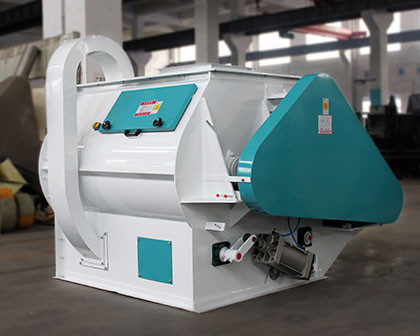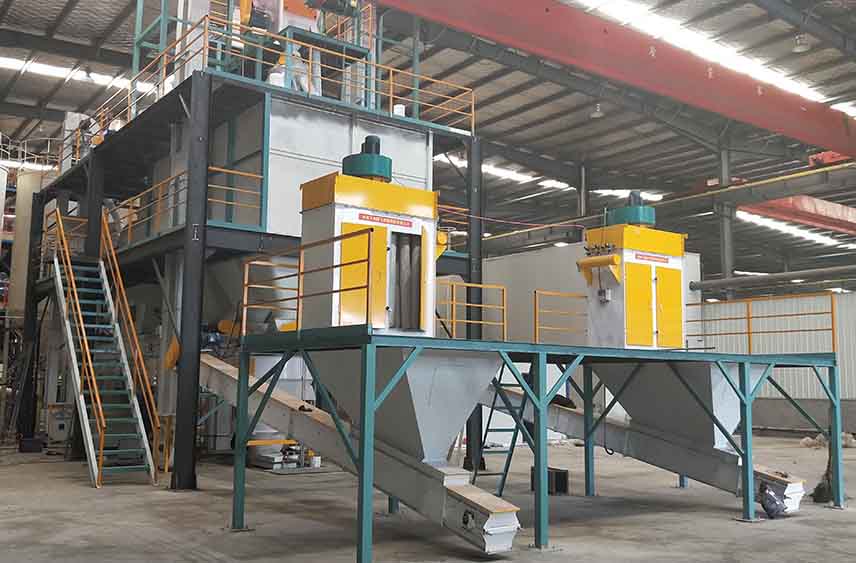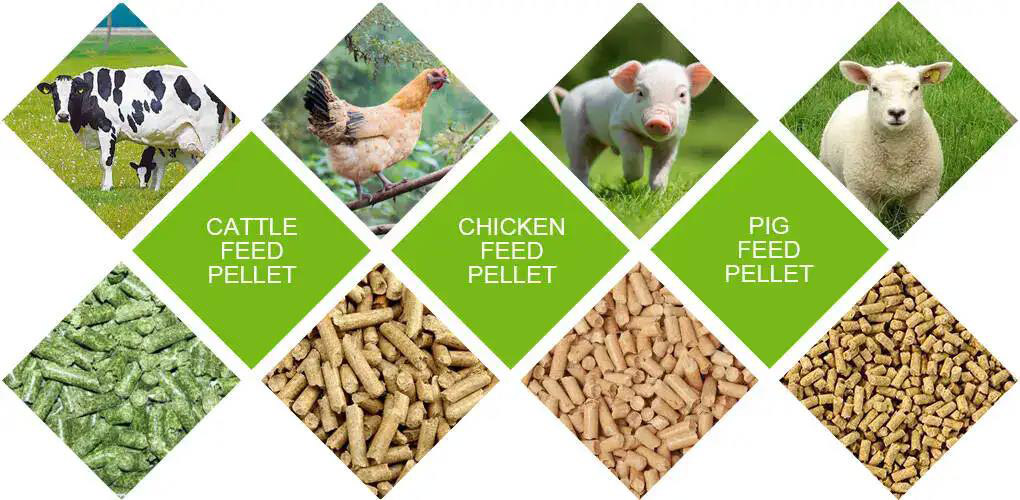A pig feed production line refers to a combination of specialized equipment and processes designed for the production of pig feed. These lines take into account the physiological characteristics and nutritional requirements of pigs at different growth stages (such as piglets, fattening pigs, etc.) and formulate corresponding feed recipes. Through a series of process steps, the raw materials are processed into the final feed products.
The pig feed production line actively comprises a complete set of equipment dedicated to producing pig feed. It proactively incorporates stages such as raw material crushing, mixing, granulation, cooling, and screening. This line takes the lead with its high production efficiency and consistent product quality, effectively catering to the requirements of both large farms and smaller feed processing facilities.
Feed Mixing Machine There are 2 types of feed mixers for complete feed pellet line: horizontal ribbon mixer and double-shaft paddle batch mixer. The first one is most commonly used and saves energy; the latter one can add liquids.

The design and structure of the pig feed production line fully take into account the user’s factory building and actual demand for output, and have the following characteristics:
The production line’s compact design minimizes construction costs and its efficient structure streamlines the process, cutting energy and material use.
The production line prioritizes cost-effectiveness with durable materials, low maintenance, and operational costs, effectively saving users’ expenses.
The production line employs a ring-die pellet machine for efficient, stable operation, enhancing continuous production and efficiency.
We can customize this production line to meet the varied needs of farmers, showcasing its strong adaptability.
We make feed tailored to pigs’ growth stages, using varied materials and formulas for their nutrition.
The production line readily adapts to market demand by adjusting product structure and output, showcasing strong market adaptability.

Coban actively markets pig feed production lines that are compact, economical, and practical, meeting the needs of large-scale intensive breeding.
The production line significantly boosts efficiency, ensures quality, cuts costs, and enhances market competitiveness, promising broader use with the industry’s growth.
The following are some of the features of Coban feed pellet machines and their advantages compared to other companies products.
| Model | Capacity(T/H) | Main Motor Power(kw) | Feeder Motor Power(kw) | Conditioner Power(kw) | Dia.of Ring Die(mm) | Final Pellet(mm) |
| SZLH250 | 1-2 | 22 | 0.75 | 1.5 | 250 | 2-12 |
This feed pellet machine can process chickens, ducks, cattle, sheep, pigs, rabbits and some aquatic products and pet feed at the same time.High efficiency, low power consumption and simple installation.The particle diameter can be switched between 2-6 mm, and the particle length can be adjusted at will.
1. Simple structure, wide adaptability, small footprint and low noise.
2. Powdered feed and grass meal can be granulated without adding a little liquid, so the moisture content of the pellet feed is basically the moisture content of the material before granulation, which is more convenient for storage.
3. Chicken, duck, fish, etc. can obtain higher economic benefits than mixed powder feed.
4. Dry material processing, the feed particles produced have high hardness, smooth surface and internal ripening, which can improve the digestion and absorption of nutrients.
5. The granule formation process can denature the pancreatic enzyme resistance factors in cereals and beans, reduce adverse effects on digestion, kill various parasite eggs and other pathogenic microorganisms, and reduce various parasites and digestive system diseases.
| Model | Capacity(T/H) | Main Motor Power(kw) | Feeder Motor Power(kw) | Conditioner Power(kw) | Dia.of Ring Die(mm) | Final Pellet(mm) |
| SZLH250 | 1-2 | 22 | 0.75 | 1.5 | 250 | 2-12 |
| SZLH320 | 3-4 | 37 | 1.5 | 2.2 | 320 | 2-12 |
| SZLH350 | 5-7 | 55 | 1.5 | 3 | 350 | 2-12 |
| SZLH420 | 8-12 | 110 | 1.5 | 7.5 | 420 | 2-12 |
| SZLH508 | 10-18 | 160 | 2.2 | 11 | 508 | 2-12 |
| SZLH558 | 15-25 | 180/200 | 2.2 | 11 | 558 | 2-12 |
| SZLH558D | 14-22 | 160/180/200 | 2.2 | 7.5 | 558 | 2-12 |
| SZLH678 | 20-30 | 220/250 | 2.2 | 11 | 678 | 2-12 |
| SZLH678D | 15-25 | 200/220/250 | 2.2 | 11 | 678 | 2-12 |
| SZLH768 | 25-40 | 280/315 | 2.2 | 11 | 768 | 2-12 |
| SZLH858 | 25-42 | 280/315 | 2.2 | 15 | 858 | 2-12 |
Typically, the production of pig feed production line uses raw materials such as corn, soybeans, wheat, and other nutrients as the formula. Our pig feed production line are specially used to produce feed for poultry, livestock, pigs, horses, cattle, sheep, chickens, ducks, goose and other animals.For different animals, with different growth cycles, (chicks, suckling pigs, calves, etc.), the feed pellet size required is different, but our feed production line only needs to replace ring molds with different apertures or use a pellet crumbler to reach the required size.
